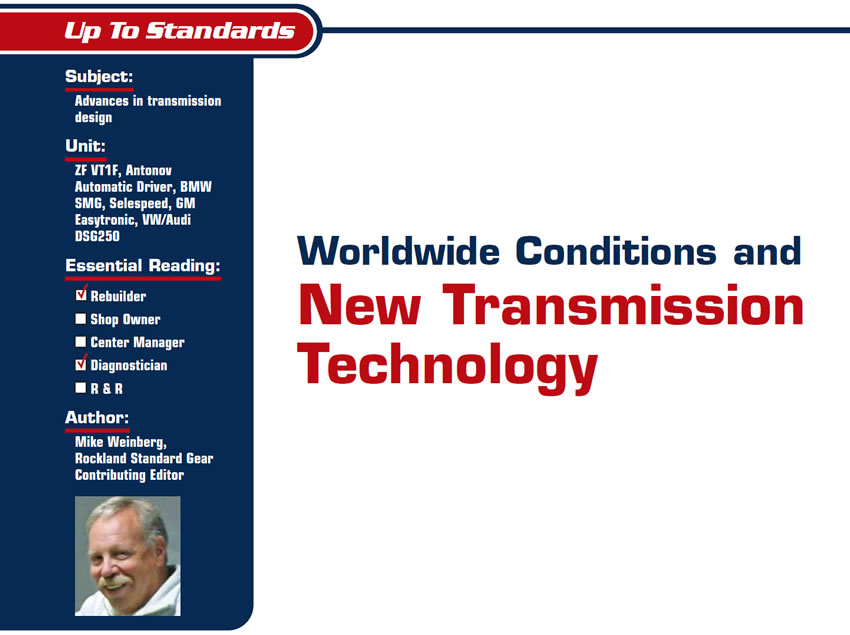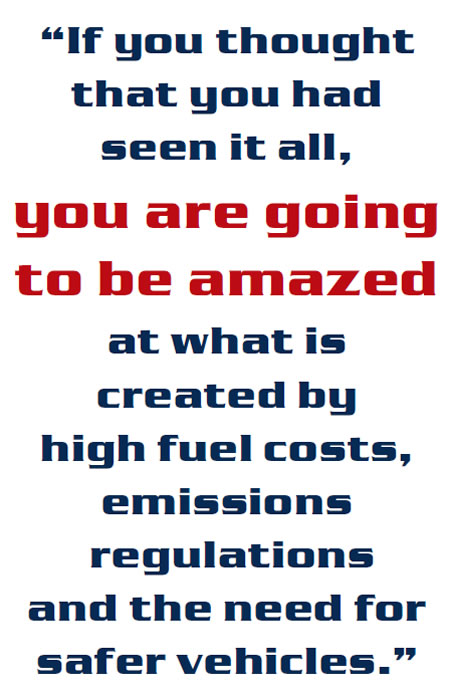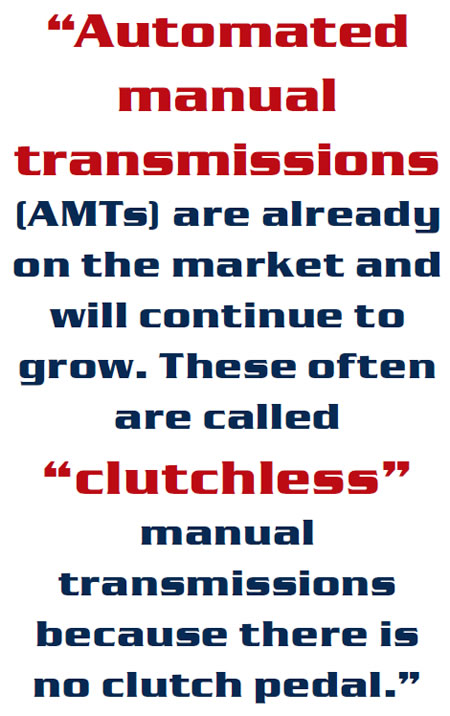
Up To Standards
- Subject: Advances in transmission design
- Units: ZF VT1F, Antonov Automatic Driver, BMW SMG, Selespeed, GM Easytronic, VW/Audi DSG250
- Essential Reading: Rebuilder, Diagnostician
- Author: Mike Weinberg, Rockland Standard Gear Contributing Editor
With the technological advances of the past 100 years the world has become smaller. Fax machines, the Internet, cell phones and the globalization of industry have created a business climate that is evolving at an incredibly rapid pace.
We have seen many changes in the automobile and the components we work on, and the rate of change is only going to increase rather than slow down. There are many factors that are driving this endless development of new designs and technology. It is important that we understand the forces that are driving the new engineering and to be prepared for the new types of transmissions we are about to see in the market.
The main issues that control the creation of more-advanced technology are legislation, environmental concerns, safety, increasing cost of fuel, advanced electronic engineering and advances in engine design efficiency. Governments create legislation in an effort to change for the better; fuel economy, emissions and safety of vehicle occupants, for example. This puts an added burden on manufacturers to meet these new standards or withdraw from certain markets.
At present there is a big push to limit emissions of carbon dioxide (CO2) that are being blamed for “global warming.” The ACEA, which is the European vehicle manufacturers’ association, has put a target limit of 140 grams per kilometer for automotive CO2 emissions for 2008. Forget that “global warming” is a theory and not based on scientific facts; it is influencing and forming legislative and public opinion and causing a glut of new regulations.
I am not a scientist, but I have common sense, and all this theory flies in the face of established science. For instance, geologists and paleontologists can show that throughout the billions of years the earth has been in existence the climate has warmed and cooled many times before there was any industrial input by man. Another commonly ignored fact is that plants take in CO2 and sunlight and through photosynthesis produce oxygen and plant growth that feeds and houses the world population.
During the dinosaur ages, the earth’s atmosphere was richer in CO2 because of the large amount of volcanic activity. This produced millions of years of the largest animals that ever walked the earth, the largest plants that ever grew, insects of immense size etc. If you increased the CO2 levels in the atmosphere by 2%, established science says that you would double your crop yields and end hunger worldwide.
All this global-warming theory is based on computer models that may not be correct. So pardon me if I have a jaundiced view of the current wave of pseudo-science sweeping over the globe. I remember that these are the same geniuses who said the world would end in 2000 with Y2K – which turned out to be the greatest computer-equipment marketing scam in history – and told us 40 years ago that margarine would make us live forever and that fresh milk, butter and eggs were bad for your health.
Sorry for the side trip, but the frustration of listening to so many “talking heads” and politicians who couldn’t find their butt with both hands makes me mean and ornery. Regardless of whether the science is sound, the governments are going to do it, so you must have new technology to meet the new standards.
Automotive-engine technology in both gas and diesel has advanced tremendously. In the 24 Hours of LeMans race this year, a diesel-powered Audi prototype race car won going away. Beyond that, the engine was the quietest of anything in the field, produced the most horsepower and torque, and was the most fuel-efficient and, obviously, the most durable. The efficiency levels of the new power plants will increase by small increments; the greatest gains will be made with advanced transmission technology.
As safety standards are increased and electronic systems such as traction and stability control become common on lower-priced models, the design of the component package of the vehicle becomes tighter and tighter. This is driving the transmission designers to smaller, more-efficient and stronger transmissions using highly advanced technology. The increase in horsepower now available from every manufacturer with smaller-displacement engines has created the need for more-durable and efficient gearboxes.
I have seen a GM four-cylinder Ecotech engine that is producing more than 1,000 horsepower on gasoline. Since 1990 you have seen continual changes in transmission design, in which manual transmissions went from four-speeds to six-speeds and automatics went from three- and four-speeds to five- and six-speeds, with a couple of seven-speed units making appearances.

If you think this was a lot of change, be prepared for a whole new world. The manual transmission as we know it is the most-efficient design, with relatively light weight, cheap production costs, highest fuel efficiency and high torque ratings. The drawbacks have been poor emission control because of variations in driver control, skill levels and comfort. Since stick transmissions shift at closed throttle and the driver has ultimate control of throttle opening and gear selection, emissions control is very difficult.
Now, let’s look at the other designs that we will see more of shortly.
Continuously variable transmissions (CVTs) are evolving into more-efficient designs. These units always had a design drawback because of low torque capacity. New engineering has started to overcome these limitations. The ZF VT1F CVT in the Mini Cooper gets better fuel economy and is better off the line than current automatic units, in a very small package.
New designs using chains, such as the Audi Multitronic, have overcome the problem of belt drives’ torque limitations. In 1998 Audi demonstrated that in collaboration with LuK, it could develop a CVT that could live behind a 2.8-liter engine with 206 lb.-ft. of torque. This gearbox has ratios that start at 12.5-1 and end up with an overdrive ratio. Through advanced electronic systems the engine speed is closely controlled to make the transmission use all the available torque with low slippage and high efficiency. This unit weighs 20 pounds less than the ZF five-speed and gets 10% better fuel mileage than the five-speed automatic. Ongoing development in design has a torque-limit goal of 368 lb.-ft.
The Japanese are not sitting idly by, either, and have extensive CVT programs going between Bosch and Aisin AW. You will see CVTs in Hondas, Mexican-built Nissan Sentras and American-built Nissan Altimas and Maximas. The Nissan Murano has a CVT, and one is supposed to be in the Dodge Caliber for production in the 2007 model year.
Infinitely variable transmissions (IVTs) often are confused with CVTs but are not of the same design. Actually a toroidal or bevel-ring-drive transmission, this design has the ability to handle very high torque loads, and many companies are working on advancing this design. This transmission has been used in motor scooters, motor cycles and John Deere tractors. A British company, Torotrak, has variations running in large U.S. 4x4s and 34,000-lb.-GVW trucks and recently demonstrated the technology in a Ford Expedition with a 5.4-liter engine. The company was able to show better fuel mileage than with a conventional four-speed automatic in that vehicle. This design ultimately will deliver a 10% fuel savings over a six-speed automatic, with lighter weight and a smaller package. Present drawbacks include low volumes of production keeping costs high. You will se this design become a presence in the next decade.

Antonov Automatic Driver (AAD) is a transmission design that uses two simple planetaries but eliminates the torque converter and the high-pressure hydraulic system found in present automatics. A six-speed electronically controlled design was introduced in 2002 and has been in development since then. The design uses forces naturally created within a helical-gear transmission, in that it combines the axial thrust levels generated by the gear train with the inertia generated by the moving assemblies. The advantages claimed over a four-speed automatic are quicker acceleration, greater top end, better throttle response and kick-down, increased fuel savings by up to 20%, better wheel dynamics, no interruption of power to the wheels during shifts, less precision manufacturing than required for a CVT and low unit costs. Honda is now in agreement to begin development of this technology.
Automated manual transmissions (AMTs) are already on the market and will continue to grow. These often are called “clutchless” manual transmissions because there is no clutch pedal. There is, however, a clutch that is computer controlled with no driver input. The BMW SMG (sequential manual gearbox) is used in the M3 and M5 models, and the Selespeed is found in Ferrari models. These can be driven in either an automatic-shift mode or manual control using a shift lever or paddles mounted on the steering wheel to permit the driver to upshift or downshift. The computer controls will even blip the throttle during a downshift to match the rpm level of racing “double-clutch” shifting. The design permits absolute emission control by the engine-management system for lower emissions levels; better fuel economy, since the computer can control engine speed and shifts better than the average driver; protection of the engine from over-revving; and prevention of missed shifts. GM has a version called Easytronic that has a self-adjusting clutch and can be added to a five-speed gearbox without modification. The inherent efficiency gained by losing the weight and slippage in a torque converter and the easy adaptation of this package to most existing designs will make this type of unit increase in volume.
Dual-clutch technology (DCT) is a design being developed by VW and BorgWarner. The transmission is known as the DSG250 and is available in the VW Golf and Touran and Audi TT with the 3.2-liter engine. It consists of two parallel shafts with two clutches, one of which handles 1st, 3rd and 5th and the other 2nd, 4th and 6th gears. To make a shift from 1st to 2nd, the transmission selects 2nd gear when its shaft is inactive. At that point the 1st-gear shaft is declutched and the 2nd-gear clutch is engaged, providing a shift quite similar to that of an automatic transmission with no clutch input by the driver.
This design shifts better than the present AMTs because of less-abrupt torque transfer. Development of better clutch applications and shift controls is ongoing. This design is here to stay, since it is cheaper and more efficient than an automatic and has more-comfortable shifts than an AMT.
The ongoing electronic-shift designs of automatic transmissions will continue to improve, and new designs of all these transmissions will become necessary as more hybrid and alternative-fuel technology enters the market. There will be more different designs to diagnose and repair, and the changes are going to keep coming. If you thought that you had seen it all, you are going to be amazed at what is created by high fuel costs, emissions regulations and the need for safer vehicles.














